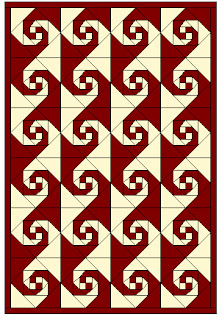This is a block that is intriguing by itself, but when put together with other of the same block...well, to me it's like magic!
You can make it as a two color block/quilt, which is what we'll do here, but you can also make it as a 3- or even 4-color block.
For a 12" block you'll need:
LIGHT fabric:
(2) 2" squares
(1) 4-1/4" square, cut diagonally (you'll use just 2 of these for one block)
(1) 3-7/8" square, cut in half once diagonally
(1) 7-14" square, cut in half twice diagonally (you'll use just 2 of these for one block)
(1) 6-7/8" square, cut in half diagonally
DARK fabric:
(2) 2" squares
(1) 4-1/4" square, cut diagonally (you'll use just 2 of these for one block)
(1) 3-7/8" square, cut in half once diagonally
(1) 7-14" square, cut in half twice diagonally (you'll use just 2 of these for one block)
(1) 6-7/8" square, cut in half diagonally
You're going to build the block from the center out:
1) Piece a 4 patch, using the 2" squares
From this point on, you'll be building out with triangles, as you did with the Square-in-a-Square. (This is a square-in a square-in a square-in-a square in a square!)
2) Add a light triangle cut from the 4-1/4" square to one side of the 4-patch, making sure the light square on that side of the 4patch is on the left side of the hypotenuse (long side) of the triangle. Sew another light triangle from the 4-1/4" square on the opposite side.
3) Add a dark triangle cut from a 4-1/4" square on one of the other sides of the 4-patch, and another on the opposite side.
Continue to add triangles in this fashion, using triangles in this order (and being careful the side on which you sew the first triangle--when the triangle you are adding is at the top/north, the triangle of the same color on the previous round will be on the left; consult diagram of completed block below, if necessary):
4) light, then dark, triangles cut from 3-7/8" squares
5) light, then dark, triangles cut from 7-1/4" squares
6) light, then dark, triangles cut from 6-7/8" squares
If you put the squares together in a straight set, it looks all right
or you can turn every block in each row:
Or, you can turn them until the outer triangles of the same color all meet, to make the classic design:
This is a wonderful, classic!


























